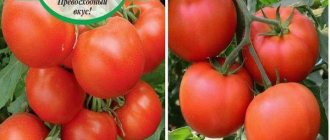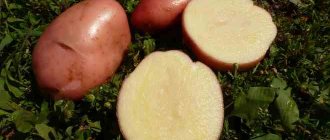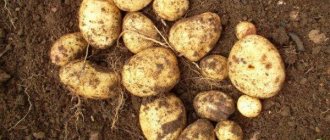Description of the potato variety Typhoon
Getting acquainted with the Typhoon variety should begin with a description, external data and taste. Features of the variety:
- oval or round fruits;
- the yellow peel is thin, smooth with a small number of eyes;
- the tops are erect, the bush is large, spreading, heavily leafy;
- large snow-white flowers;
- The pulp is dense, juicy, creamy or yellowish in color.
The Typhoon root crop has gained great popularity not only for its ease of care, but also for its excellent taste. The variety is for table use; after heat treatment it does not crumble or lose its shape. Thanks to this characteristic, the Typhoon root vegetable is ideal in fried, boiled, baked form and is suitable for making French fries.
Vega Potatoes
In practice, this variety in Russia is grown from Kaliningrad to Novosibirsk and from Arkhangelsk to the southern borders, which confirms its flexibility in production and popularity among consumers.
VEGA . High yield and excellent quality of tubers even in conditions of lack of moisture are a stable result for those who choose Vega potatoes. It is no coincidence that this variety is becoming increasingly in demand both in Russia and in Europe.
Vega is a mid-season table variety of a new generation. Potatoes are characterized by beautiful oval tubers, yellow skin and dark yellow flesh. The pulp is distinguished not only by its rich color, but also by its resistance to darkening in raw and cooked form. The variety is high-yielding, large-tuberous, the average number of tubers in a nest is 12-15. Potatoes are slightly boiled, universal for cooking, and have an excellent taste.
The variety is highly resistant to virus Y, late blight of tubers and tops, rhizoctonia, blackleg and scab. Vega has all the prerequisites to be in the top set of varieties of Russian potato producers.
Why do we think this? Firstly, Vega is a “daughter” of the Gala variety, which means that the genetic potential of the variety is very high. Secondly, Vega is more flexible in terms of moisture, it is not so demanding on watering, it consistently lays its 12-15 tubers and stretches them to the desired size, which is a huge plus and makes one more inclined to choose this variety for production.
Related article: Suitable potato varieties for the Northern region
Wendy is another “descendant” of the Gala variety. The tubers of this variety have a round-oval shape (like Gala potatoes), a smooth mesh skin, and are characterized by shallow eyes (the variety is suitable for mechanical peeling).
Potatoes are famous for their excellent taste and very long shelf life without a tendency to premature germination.
The variety is interesting both in the production of fresh table potatoes and in the industrial production of semi-finished products.
Fidelia is a new variety included in the register of breeding achievements in 2014. However, it has already proven itself well and has good prospects in the catering sector.
Fidelia is an early table variety that can be classified as a “salad” (not soggy) variety. Due to the stability of the product, boiled and sliced potatoes are not destroyed in mayonnaise and other dressings, which is an important characteristic for their use in the production of salads.
Pirol and Kibits are varieties for processing into chips.
Pyrol is a variety with a consistently low content of reducing sugars; the tubers can be used for processing even after long-term storage.
Kibitz is the only chip variety of its kind that does not change the structure of sugars and maintains the product quality necessary for the production of chips under storage conditions of +4 °C.
This season, the choice in favor of these varieties was made by farms producing potatoes for. Also, these varieties, especially the Kibits variety, show excellent results in Siberia (grown potatoes are processed into chips).
Norika breeders do not stop there. Two more promising early varieties will soon appear in Russia. This year we are submitting two new light-skinned varieties for state variety testing - Nixe and Paroli.
Nikse is a high-yielding mid-early variety with long-term storage, characterized by excellent commercial quality and a fairly high starch content - 16%.
Paroli is a variety intended to supply the market with early table potatoes. Showed good results in field tests in Europe.
The results of the variety trials already give reason to assume that the new varieties are confident candidates for inclusion in the “State Register of Breeding Achievements Approved for Use” and have enormous potential in our country.
We invite those who wish to personally evaluate the quality of Norika varieties and receive qualified advice on their cultivation to visit the stand of Norika-Slavia LLC at traditional specialized events. This year the company will take an active part in a series of exhibitions and field days.
During the meetings, we will present varieties such as Gala, Vega, Inara, Wendy, Fidelia, as well as new varieties - candidates for inclusion in the State Register: Baltic Rose, Nixe and Paroli.
Typhoon (Tajfun) is a mid-early nematode-resistant variety, the first of the Polish varieties included in the Register of Plant Varieties of Ukraine (2008). This variety is a really good gift for Ukrainian potato growers during a changing climate. Its unpretentiousness, resistance to unfavorable weather conditions (easily restored after frost and hail), resulting in consistently high yields combined with high taste and large clubbing have already made Typhoon one of the “favorites” of Ukrainian potato growers. The experience of the first years of testing the variety on Ukrainian lands confirmed its drought resistance, proven in other countries (the ability to absorb moisture from deeper soil horizons and limit its evaporation by the leaf apparatus). The alternation of dry and rainy periods during the growing season does not lead to cracking, hollowness and overgrowth of tubers - disadvantages characteristic of many old varieties. Typhoon is resistant to especially dangerous viruses Y, L and M, moderately resistant to late blight and common scab, and has good shelf life.
The bush of this potato variety is powerful, well-leafed, the leaves are light green, the flowers are white. The tubers are very large, oval, regular in shape, with small eyes, and have a good presentation. The color of the peel is yellow, the pulp is light yellow. The tubers have high taste, do not darken when cooked, are slightly softened, and are suitable for making chips.
New potato varieties
At the Institute of Potato Growing of the Ukrainian Academy of Agrarian Sciences, new potato varieties were created, which in 2004-2006. passed state variety testing and since 2007 have been included in the State Register of Plant Varieties of Ukraine.
Article on the topic: Potato variety Veneta (Vineta) - description and photo
Leading varieties 2008
The last favorable year for growing potatoes was 2000.
Characteristics of the Typhoon potato variety
Before purchasing Typhoon seed potatoes, you need to read the description of the variety, read reviews, view photos and videos. The variety is high-yielding, has its own positive and negative qualities, and grows well in regions with short, cool summers.
Productivity
Typhoon potatoes, subject to agrotechnical rules, bring a good harvest. The weight of one root crop is about 100 g, each bush produces from 6 to 10 tubers. Therefore, from 1 sq. m you can get up to 50 kg of tasty and healthy potatoes. Typhoon potatoes grow well in any soil, tolerate long-term heat and drought, and produce a good harvest, so they are grown not only in personal plots, but also on an industrial scale.
Advantages and disadvantages
Typhoon potatoes, like any variety, have their strengths. The advantages include:
- resistance to heat and drought;
- the bush quickly recovers after spring frosts;
- the tubers do not crack or form voids during the ripening process;
- high keeping quality;
- early fruiting;
- good taste and presentation;
- low susceptibility to mechanical damage;
- resistance to diseases and pests.
Important! No deficiencies were found in the Typhoon potato variety.
Advantages and disadvantages
"Typhoon" has the following advantages:
- Resistant to heat and drought;
- Rapid recovery of bushes, maintaining productivity, after frost and hail damage;
- Resistance to cracking, hollowness and growth of root crops, as a result of alternating dry periods and heavy rainfall;
- Excellent keeping quality (95%);
- High taste characteristics;
- Resistant to viral diseases and potato nematode;
- Immunity to mechanical damage.
There are no significant disadvantages to the Typhoon potato variety.
We invite you to familiarize yourself with potato varieties that have different ripening periods:
Landing rules
To obtain a high yield, it is necessary to comply with planting dates and carefully prepare the planting site and material. The choice of planting methods will also be important.
Recommended timing
The timing of planting Typhoon potatoes depends on the region of growth. In the southern regions, potatoes are planted from mid-April; in regions with an unstable climate, planting is done in mid-May. The main aspect is warming the soil to + 10-15 °C. But since not every gardener can measure the soil temperature, the timing of planting potatoes can be determined by folk signs (if the first leaves appear on the birch tree, it means the soil has warmed up to + 10 °C).
Soil preparation
From the description it is clear that Typhoon potatoes can grow on any soil and in any climate. But to get a rich harvest, it is necessary to prepare a place for planting in early spring or late autumn. To do this, dig up the soil onto the bayonet of a shovel and apply mineral and organic fertilizers.
Important! The planting site should be located in a sunny place. The best predecessors for potatoes are: corn, cucumbers, cabbage and root vegetables.
To get the long-awaited harvest, the soil must be light, well-drained and nutritious. If the soil on the site does not meet the established standards, then it can be improved as follows:
- Clay soil is diluted with humus or peat.
- Sandy soil is improved with clay.
- Peat soil is diluted with sand, rotted compost and clay.
Also, to improve the quality of the soil, superphosphate, potassium and wood ash are added. During autumn digging, organic matter is added. This could be chicken droppings, slurry, rotted compost or humus. All organic fertilizers are diluted strictly according to the instructions so as not to oversaturate the soil with nitrogen.
How to plant correctly
Before planting, it is necessary to prepare the tubers. To do this, you can use the following recommendations:
- treatment in a growth stimulator;
- The tubers are kept in a solution of copper sulfate for 2-3 minutes;
- planting material is germinated in the light, in warmth or due to minor mechanical damage.
Typhoon potatoes can be planted in several ways, it all depends on the climate and soil quality.
The most common methods:
- Using a shovel is the most commonly used method. It consists of digging a hole and immersing seed potatoes there. The method is suitable for ordinary, moderately acidic soil.
- Ridge method - suitable for clay soil. Potatoes are placed in the ridges made to a depth of 6 cm, with an interval of 50-70 cm. This method has a number of positive aspects: the soil is ventilated and warms up quickly, the root system grows, and the yield increases.
- In trenches – suitable for sandy soil. To do this, dig a trench 15-20 cm deep and lay out the potatoes at a distance of half a meter from each other.
- Into hay is a new and effective way to grow potatoes. Planting material is laid out on a bed, covered with soil and covered with a 20 cm layer of hay. Since after watering the hay will settle and decompose, it is necessary to lay a new layer 2-3 times per season. This method is good because hay stops the growth of weeds, retains moisture and nourishes the soil.
Planting and caring for Typhoon potatoes
As practice shows, to obtain a high level of yield, Typhoon potatoes should be properly cared for. Among the main measures for caring for plants are:
- timely hilling of potatoes, especially at a time when active growth of tops is observed;
- weeds must be removed immediately as soon as they appear;
- loosening the soil;
- if there is a drought, it is necessary to establish a crop irrigation system;
- Throughout the season, it is necessary to apply fertilizer 2 times, especially if the root crops grow on poor soils.
To prevent weed growth, it is recommended to mulch the soil.
Selection and preparation of a landing site
As you know, to obtain a high level of harvest, it is necessary to first select and prepare a plot of land. Judging by the characteristics and reviews, Typhoon potatoes can be grown on any soil.
Before planting the crop in open ground, it is recommended to dig up the selected plot of land and carefully remove the weeds along with the root system. If the soil is infertile, it is worth adding fertilizers.
Preparation of planting material
Preliminary preparation of planting material can significantly increase the level of productivity. To process root crops, you can use the following means:
- growth stimulator - the composition includes microelements, thanks to which the process of awakening the eyes is accelerated;
- drugs that prevent the occurrence of diseases - in this case, you can use a solution of copper sulfate, into which the tubers are dipped for 2-3 minutes;
- means that protect tubers from pests.
If necessary, planting material can be germinated.
Landing rules
When carrying out planting work, you should adhere to the following rules:
- for growing Typhoon potatoes, it is recommended to choose black soil, sandy, loamy or peat soils;
- Potatoes can be planted in open ground at a time when the average daily air temperature outside is +15°C. As a rule, potatoes are planted in soil heated to +7°C to a depth of 12 cm;
- planting work is carried out from April to May. The early planting process allows harvesting in mid-summer. Young potatoes are eaten, and for storage they use earlier root crops that were planted back in May;
- There should be a distance of up to 35 cm between bushes, and the width between rows should not be less than 65 cm.
To obtain a high yield, it is recommended to plant Typhoon potatoes in areas where flax or lupins previously grew.
Advice! It is not recommended to plant Typhoon potatoes in one area for several years in a row, as the amount of harvest will be significantly reduced.
Watering and fertilizing
If you follow all agrotechnical rules in the process of growing typhoon potatoes, then it is worth considering that the crop must be irrigated once a week. As a result of the fact that potatoes are usually planted in large areas, they are watered once every 1-2 months. During the season it is worth applying fertilizers at least 2 times, which will allow you to get a high yield.
Loosening and weeding
Weeding Typhoon potatoes is important. Emerging weeds interfere with the growth and development of tubers, as weeds take all nutrients and moisture from the soil
As a rule, removing weeds and loosening the soil is done simultaneously with hilling the potatoes. It is recommended to remove weeds 3-4 times throughout the season.
Hilling
With the help of hilling you can retain moisture, get rid of weeds and protect the crop from possible frosts
In addition, it is important to understand that this procedure helps to increase productivity, as air circulation improves in the places where the tubers are poured. Potatoes are hilled every time after rainfall or watering
Features of cultivation
The description of the Typhoon potato, photos and reviews show that the variety is unpretentious and produces a generous harvest even with minimal care. But in order to grow high-quality potatoes, you need to carry out timely watering, fertilizing, hilling and loosening the soil.
Watering schedule
Typhoon potatoes are a drought-resistant variety, but in the hot, dry season it is difficult to grow a large crop without timely watering. For the entire season, potatoes need three irrigations:
- after emergence;
- during the formation of buds;
- after flowering.
Important! Watering is carried out abundantly so that moisture penetrates to a depth of half a meter. If the tubers lack moisture, the tops lose their elasticity and take on a limp appearance.
Loosening, weeding, hilling
To prevent weeds from taking up moisture and nutrients, it is necessary to get rid of them in a timely manner, combining them with loosening and hilling.
Hilling allows you to get more tubers from each bush. It is carried out in regions with frequent rains and short summers. Hilling rules:
- The procedure is carried out in the morning or evening hours.
- The soil should be well watered.
- The bush is earthed for the first time after the plant reaches 20 cm in height.
- The second - 20 days after the first time.
In the southern regions, experienced gardeners do not recommend hilling potato bushes. Since if the summer is hot and there is no time to water, the potatoes can bake right in the ground. In such cases, light loosening of the soil will be sufficient for better air permeability.
Do I need to feed
If Typhoon potatoes are planted in depleted soil, then several feedings are necessary to obtain a harvest. For this purpose, mineral and organic fertilizers are used:
- The first mineral complex is introduced a month after planting. To do this, use urea, super phosphate, potassium chloride, diluted strictly according to the instructions.
- The second fertilizing is applied at the moment of bud formation.
- The third - after the end of flowering.
Important! If the potato tops have grown powerful and densely leafy, then it is better to refuse nitrogen.
Pests and diseases
Typhoon potatoes are resistant to many diseases and pests. But if agrotechnical rules are not followed, unexpected guests may settle on the crop.
The Colorado potato beetle is the most common pest that appears during flowering and tuber formation. Without treatment, a harmful insect can destroy the entire potato crop in a short time. To combat the pest use:
- manual collection;
- treating the bush with broad-spectrum insecticides;
- spraying with infusion of tansy, currant, celandine or basil.
In order not to encounter difficulties, it is necessary to carry out preventive measures:
- observe crop rotation;
- plant green manure and herbs;
- When the first signs appear, begin treatment immediately.
Wireworms often attack tubers. The insect does not destroy the crop, but the passages made are an entry point for nematodes and infections. As a result, the tubers rot and become unfit for consumption. The pest can be detected by the appearance of the bite. The tops become sluggish and lose their elasticity, the plant lags behind in growth and development. To protect potatoes from wireworms, you need to:
- Before planting, fertilize the soil with ammonium nitrate.
- Reduce acidity using dolomite flour or slaked lime.
- Weed and loosen the soil in a timely manner.
- Before planting, treat the planting material in the preparation “Tabu”.
The potato flea beetle is a dangerous pest that destroys all above-ground parts. For potatoes, both adult individuals that feed on leaves and larvae that attack the root system are dangerous. If the plant is attacked by a pest, the foliage becomes dark brown, dries out and falls off. Broad-spectrum insecticides are used to get rid of insects. You can also treat the bush with chamomile infusion and tobacco and wood dust.
Harvesting and storage
Typhoon potatoes are an early ripening variety. Harvesting is carried out 60-70 days after planting. Collection and storage rules:
- a month before harvesting, mow down the tops;
- Next, choose a sunny day and remove the potatoes from the ground; you can use a shovel or pitchfork for this;
- the bush is shaken off the ground, the grown crop is separated and laid out on the bed to dry;
- Before harvesting for storage, potatoes are sorted and selected;
- tubers with mechanical damage and signs of rot are not suitable for long-term storage; they are immediately used for cooking;
- healthy specimens are laid out in boxes and stored in a cool room.










